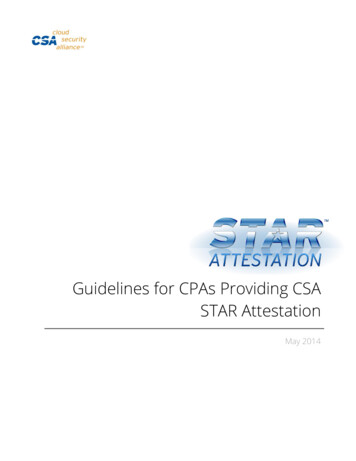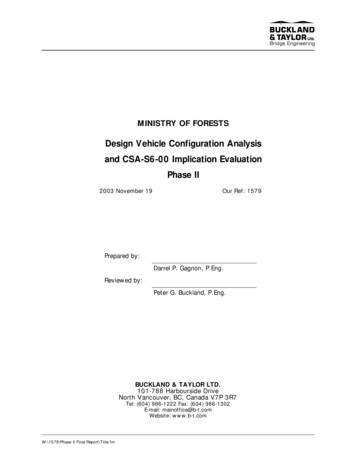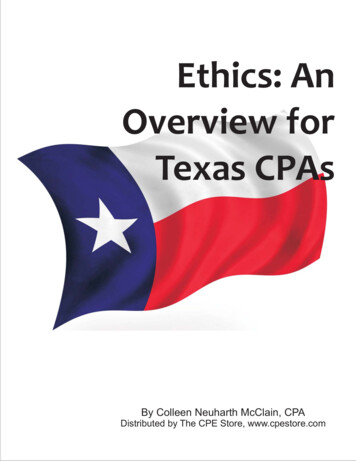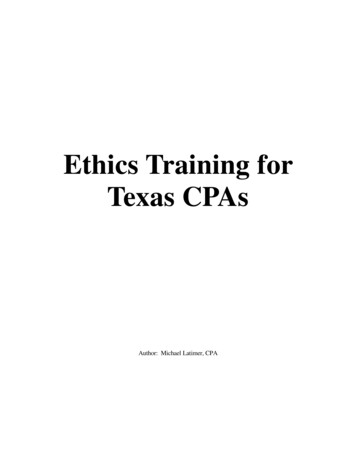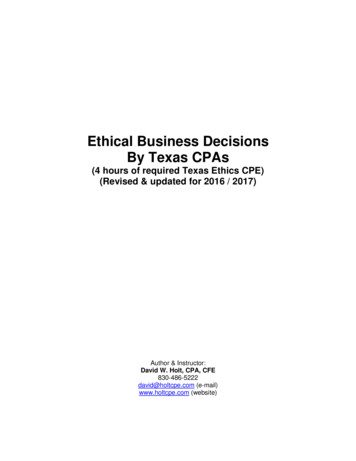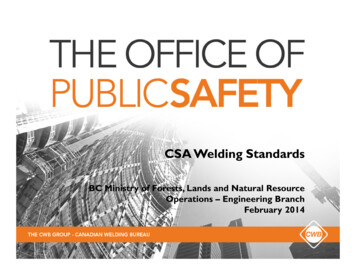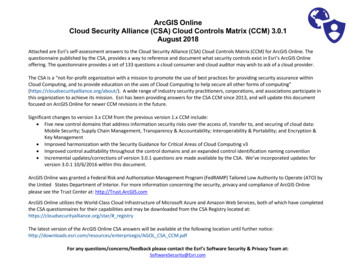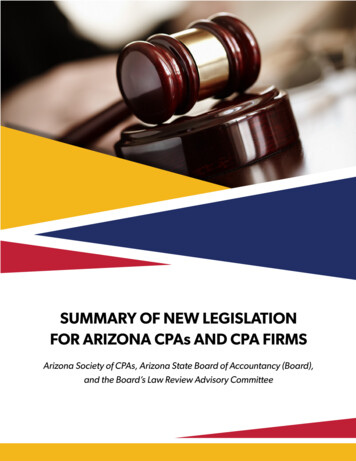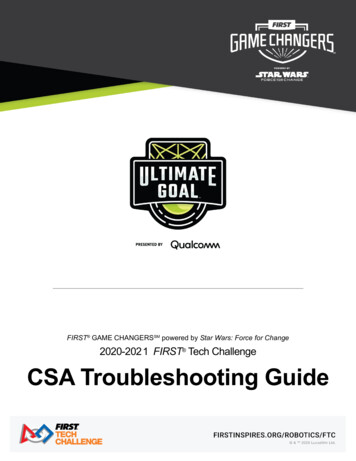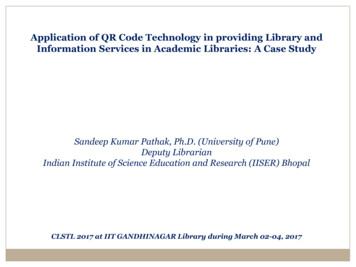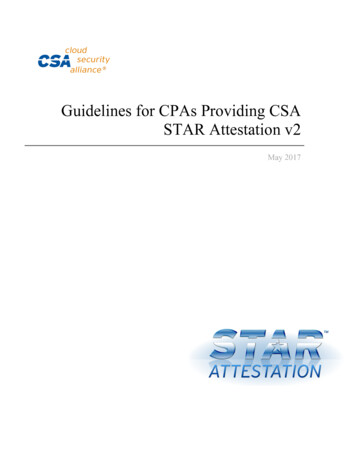
Transcription
Guidelines for CPAs Providing CSASTAR Attestation v2May 2017
2017 Cloud Security Alliance – All Rights ReservedAll rights reserved. You may download, store, display on your computer, view, print, and link to the CloudSecurity Alliance “Guidelines for CPAs Providing CSA STAR Attestation” at www.cloudsecurityalliance.org/star,subject to the following: (a) the Document may be used solely for your personal, informational, non-commercialuse; (b) the Document may not be modified or altered in any way; (c) the Document may not be redistributed;and (d) the trademark, copyright or other notices may not be removed. You may quote portions of theDocument as permitted by the Fair Use provisions of the United States Copyright Act, provided that youattribute the portions to the Cloud Security Alliance “Guidelines for CPAs Providing CSA STAR Attestation” (2017) 2017 Cloud Security Alliance - All Rights Reserved.2
IntroductionThis document provides guidance for CPAs in conducting a STAR Attestation. This document is not meant toreplace any American Institute of Certified Public Accountant (AICPA) Standards or AICPA Service OrganizationControl (SOC) related guidance. Refer to http://www.aicpa.org/soc for information about SOC and how toobtain SOC related standards and guidance.Part 1 – Professional Requirements1 General1.1STAR Attestation is a SOC 2SM engagement in which the criteria include:1.1.1 the applicable criteria in TSP section 100, Trust Services Principles, Criteria, and Illustrations forSecurity, Availability, Processing Integrity, Confidentiality, and Privacy (AICPA, Technical PracticeAids) (TSPC), and1.1.2 the control specifications included in the Cloud Security Alliance (CSA) Cloud Controls Matrix(CCM).2 Requirements for engagement performance2.1A SOC 2SM engagement is performed by a CPA in accordance with the AICPA Statements on Standardsfor Attestation Engagements or ISAE 3000s (the “Attestation Standard”), the AICPA Guide Reporting onControls at a Service Organization Relevant to Security, Availability, Processing Integrity, Confidentiality,or Privacy (SOC 2SM Guide).2.2The Attestation Standard provides a framework for performing and reporting on all attestationengagements. The SOC 2SM Guide provides performance and reporting guidance based on theAttestation Standard for an examination of a cloud service organization’s description of its system andthe suitability of the design, and in type 2 engagements, the operating effectiveness of controls that arelikely to be relevant to the security, availability, or processing integrity of a cloud service organization’ssystem or the confidentiality or privacy of the information processed by the system. The TSPC providescriteria for evaluating and reporting on controls related to security, availability, processing integrity,confidentiality, and privacy. SOC 2 reports are generally restricted use reports as they are intended forspecified parties who are knowledgeable about the nature of the service provided by the service 2017 Cloud Security Alliance - All Rights Reserved.3
organization; how the service organization’s system interacts with user entities, subserviceorganizations, and other parties; internal control and its limitations; the applicable trust services criteria,the risks that may prevent those criteria from being met, and how those controls address those risks;and complementary user-entity controls and how they interact with related controls at the serviceorganization to meet the applicable trust services criteria.2.3The CCM control specifications constitute suitable criteria as defined by the Attestation Standard (“CCMcriteria”) and includes criteria equivalent to the criteria for the security principle in the TSPC plus certainadditional criteria related to security.3 Competency requirements3.1CPA services are subject to specific professional standards. Adherence to these standards is incumbenton CPAs under rules of the AICPA and individual state laws that have adopted these standards.3.1.1 State or Country Accountancy Laws. CPAs are licensed by the states or by countries . Becauselicensure is required to provide certain CPA services, state/national governments have regulatoryauthority over CPA activities. As a result, some CPA standards are imposed not only by theprofession, but by force of law. Violation of accountancy laws can lead to substantial fines andlicense suspension or revocation.3.1.2 Ethics Code. The AICPA Code of Professional Conduct (Code) applies to all CPA services. CPAs haveto adhere to the Code regardless of the type of service provided or the subject matter involved.The membership of the AICPA approved the rules stated in the Code, and the AICPA ProfessionalEthics Executive Committee maintains it by issuing detailed guidance. The Code establishesbehavioral standards and is supplemented by rules specific to individual services establishedelsewhere in professional standards. The rules are supplemented by interpretations and rulingsthat provide guidance relevant to applying them. The following summarizes the general rules inthe Code; the rules require the CPA to: Be independent when providing financial statement services or attestation servicesBe objective and have integrity, have no conflicts of interest, and neither knowinglymisrepresent facts or subordinate his or her judgment to othersHave professional competenceExercise due professional careAdequately plan and supervise professional services performedObtain sufficient relevant data for conclusions or recommendationsComply with the relevant professional standardsMaintain confidentiality of client information 2017 Cloud Security Alliance - All Rights Reserved.4
Decline contingent fees for certain types of clientsNot commit an act discreditable to the professionNot engage in false, misleading, or deceptive advertising or coercive, over-reaching, orharassing solicitationDecline commissions in certain types of engagements and disclose them when acceptanceis permittedPractice only in certain organizational forms and use a firm name that is not misleading.3.1.3 Quality Control. CPAs are required to apply quality control policies and procedures over theirfinancial statement and attestation services. The objective of a system of quality control is toprovide the CPA firm with reasonable assurance that that firm and its personnel comply withapplicable professional and legal and regulatory requirements and that the reports it issues areappropriate in the circumstances. There are six required elements to a system of quality control: Leadership responsibilities, that is, the tone at the topCompliance with relevant ethical requirementsAcceptance and continuance of client relationships and engagements to performengagements only when the CPA is competent and capable of doing so, can comply withrelevant requirements, and has considered the client’s integrity Human resources that ensure necessary competence, capabilities, and commitment Engagement performance, which involves consistent quality, supervision, and review,including when necessary, consultation Monitoring to ensure the system’s continued effectiveness.CPA firms’ quality control practices are periodically examined by independent outsideprofessionals. The examination determines whether quality control is effective and theexamination results in a formal report. The report is typically available to the public, allowingpotential clients and information users the opportunity to determine a CPA firm’s adherence toquality control standards. The AICPA Peer Review Board recently approved SOC 2SM engagementsas must select engagements. This means that if a firm performs SOC 2SM engagements, at leastone such engagement should be selected during its peer review.3.1.4 Continuing Professional Education. CPAs must adhere to the continuing education requirementsset forth by the State Board of Accountancy of the state/s where a CPA license is held. Therequirements for continuing professional education vary from state to state. The AICPA requirescertain CPE for maintaining membership. There are also special CPE requirements for thoseperforming work related to the Government Accountability Office (GAO).4 Scope of Attestation 2017 Cloud Security Alliance - All Rights Reserved.5
4.1In a SOC 2SM report, the CPA expresses an opinion on the following: Whether the description of the cloud service organization’s system is fairly presented, based onthe description criteriaWhether the controls are suitably designed to provide reasonable assurance that the applicabletrust services criteria would be met if the controls operated effectivelyIn type 2 reports, whether the controls were operating effectively to meet the applicable trustservices criteria and CCM criteriaIn engagements to report on the privacy principle, whether the service organization complied withthe commitments in its statement of privacy practices.5 Criteria establishment and selection5.11Paragraphs 1.26–.27 of the current1 SOC 2SM Guide contain the criteria for the description of a cloudservice organization’s system. TSP section 100 contains the criteria for evaluating the design andoperating effectiveness of controls. CSA CCM contains the control specifications which constituteadditional suitable criteria related to security.The July 1, 2015, SOC 2 Guide was the current version at the time of this document release. 2017 Cloud Security Alliance - All Rights Reserved.6
2017 Cloud Security Alliance - All Rights Reserved.7
Part 2 Additional CSA Guidelines1 CSA Competency1.1Individuals carrying out STAR Attestation engagements (in the case of an engagement team, theengagement team lead) must hold the CSA’s Certificate in Cloud Security Knowledge (CCSK) in additionto, the requirements posed in Part 1, paragraph 3.1.4 above by the State Boards of Accountancy andAICPA.2 Scope2.1The STAR Attestation program is based on the combined requirements of the CCM and the TSPC.2.2For a cloud system to qualify for STAR Attestation, its SOC 2 report scope must cover and the systemmust satisfy all CCM controls and the TSPC Security principle, and must be evaluated to ensure itincludes all activities related to the reported cloud system.2.3This scope of the reported system must be specified in the SOC 2 report under the ManagementAssertion section that, the cloud system 'has implemented and satisfies all controls in the CCM and theselected principles of TSP 100'.2.4The version of the CCM (minimum version 3.0.1) and edition of the TSPC used in the report must bespecified in the SOC 2 report under the Management Assertion section.If certain CCM controls are deemed not applicable to the cloud system, the applicant is required to offeran alternative implemented control that is able to provide equal protection to the control intention.For each excluded control, the applicant is required to specify the following information in theManagement Assertion section or description of the systems of the SOC 2 report:2.6.1 control name, control ID, rationale on exclusion, how the cloud system’s alternative controlimplementation meets or exceeds the original control intention.2.52.63 Submitting materials to CSA 2017 Cloud Security Alliance - All Rights Reserved.8
3.1Determination of submitting information to the completion of a STAR Attestation engagement will bedetermined by management of the cloud service organization.3.2Organizations that are applying for their first STAR Attestation over a cloud system, can provide a SOC 2Type 1 report to the CSA to support their application. For subsequent applications of the same cloudsystem, only a SOC 2 Type 2 report will be accepted. A system can only gain STAR attestation once basedon a SOC 2 Type 1 report. If an organization has more than one system, each system can gain attestationonce, using a SOC 2 Type 1 report.3.3Because STAR Attestation does not require mandatory follow-up engagements, the “point in time” datefor SOC 2 Type 1 reports or the “period of time” covered by SOC 2 Type 2 reports will be denoted on theSTAR Registry along with the scope covered.3.4Upon receipt of the CSA STAR Attestation submission, CSA will grant the submitter permission and usageguidelines for the CSA STAR logo and brand. Usage of the CSA STAR logo and brand is not permitteduntil explicitly granted by CSA. Further information about CSA guidelines regarding STAR Attestation isavailable at 5Due to the different level of assurance provided by the SOC 2 Type 1 versus the SOC 2 Type 2 reports,the period of validity of the resulting STAR Attestation (“basic validity period”) differs. A STARAttestation obtained based on a SOC 2 Type 1 report is only valid for 6 months from the as-of date, i.e.,an organization that received their STAR Attestation based on a SOC 2 Type 1 report is required tosubmit a SOC 2 Type 2 report to maintain uninterrupted STAR Attestation status.A STAR Attestation achieved based on a SOC 2 Type 2 report is valid for 12 months (1 year) from the enddate of the reporting period.The validity period of a STAR Attestation is extended by grace period of 3 months on top of the basicvalidity period for report generation and delivery (“maximum validity period”). This rule applies to STARAttestations based on both SOC 2 Type 1 and SOC 2 Type 2 reports. For clarity, the maximum validityperiod of a STAR Attestation based on a SOC 2 Type 1 report and a SOC 2 Type 2 report is 9 (6 3)months and 15 (12 3) months respectively.3.63.7 2017 Cloud Security Alliance - All Rights Reserved.9
2.1 A SOC 2SM engagement is performed by a CPA in accordance with the AICPA Statements on Standards for Attestation Engagements or ISAE 3000s (the “Attestation Standard”), the AICPA Guide Reporting on Controls at a Service Organization Relevant to Security, Availability, Processing Integrity, Confidentiality, or Privacy (SOC 2SM Guide).
